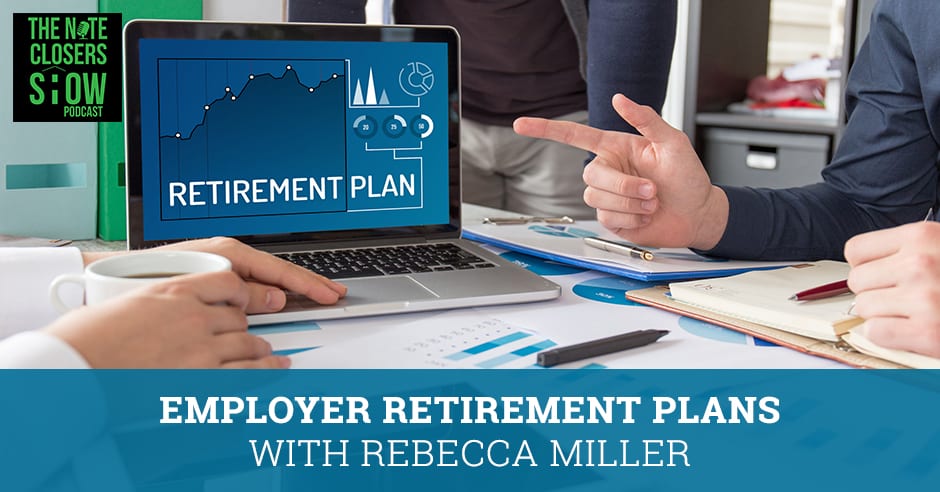
—
Listen to the podcast here
Employer Retirement Plans with Rebecca Miller
We are excited for this episode because it’s a subject we have not covered yet in the many episodes that we have had with Money Mondays. I’ve got an amazing episode with one of the most tenured Quest IRA employees, the fabulous, Rebecca Miller, joining us. How is it going, Rebecca?
It’s going great. Thank you so much for inviting me over and having me as your guest speaker. This is my first time coming onto your podcast.
Ingrid and Anne Marie had been hogging up. We had Haley on for the talk about the Quest Expo. It’s been time and I was like, “It’s time to have Rebecca on. Rebecca has been there a long time.” Congratulations as well. You celebrated nine years.
They gave me a sweet congratulations on my nine-year anniversary here. They gave me flowers and cookies in front of our office during the trainings. We do trainings every single day to keep everybody up on their game when it comes to self-directed IRA education for even our employees.
A question I like to ask is, “Did you think you’d be there for nine years?”
I did not foresee this coming at all. I started as an intern with Quest IRA. I didn’t foresee this growth. It’s been a great trip along the way as well to help me find what I wanted to do as far as what I was going to school for and to hone in on that. I’m in school part-time, believe it or not.
What are you studying?
I’m getting my Bachelor’s in Marketing and Business Administration.
That doesn’t surprise me because you do a lot of events there. You do a lot of marketing. You’ve been a very focal link in what Quest has done in marketing. I’ve been a fan and client of Quest. You’ve been a staple there for a lot of things. You’ve been in the Austin office.
I moved out to Austin, Texas from Houston to help establish that office with Beatriz, our Marketing Director here at Quest.
Now you’re up in the Dallas office as well.
I moved out to Dallas to help grow that office even further.
You are the expert there at Quest. I’ve heard the ladies, I’ve heard Nathan and I’ve heard Nate all talk about, “If you want this specific type of plan, you need to talk to our expert, Rebecca Miller.” When I come to the offices, you’re on the phone. Oftentimes you’re explaining one of these plans to the client, a potential client at Quest.
I handle a lot of our employer plans. A lot more folks work with SEP or SIMPLE IRAs because they’re more common. You can have employees with them. You can get higher contributions. It doesn’t hurt to have employees but there are some folks out there that have no employees who would like to have a Solo 401(k). This type of account has many names. They call them individual 401(k), a QRP, a single member profit sharing plan. It’s a 401(k) where a single individual has no other employees beyond possibly their spouse. I handle a lot of our consultations on this. You mentioned how I’m usually always on the phone with one of these. On average, I’d say a consultation with one of our 401(k)s takes between 45 minutes to an hour to be thorough and to go over the ins and outs of all the great things.
When somebody wants a Solo 401(k), it’s usually for a number of reasons. We also focus on the responsibilities that come with the account. It’s one thing to be gung-ho about the great things without knowing the other side of the book. That’s what I get to do is I get to handle a lot of those consultations. We are training more of our Quest employees on those too, so that we’ll be able to take on more consultations on this type of account. You may not know this, but Solo 401(k)s have an account opening deadline of December 31st. You can’t get me off the phone around that time of the year.
They don’t have the normal extended to April 15th. They’ve got to be done by December 31st because that falls in line with a lot the tax forms and things like that.
It gets stressful on December 31st. One thing that catches a lot of folks is they wait until the end of the year deadline. If you’re a W-2 employee of yourself, if you have a corporation and you’re paying yourself the W-2, that means your final contribution for the year and the setting up the account all has to be done by December 31st, which is hectic unless you’re a 1099 or Schedule C employee.
I’m assuming that on December 31st, you’re going to be the offices on the phone.
I’ll probably be on the phone that entire weekend as well.
Why don’t we talk about it so we can help people get a little bit excited about it? Figure and see if we can get their ducks in a row prior to December 31st.
A head’s up in their timeline.
Let’s talk about the great benefits of it and we’ll go from there.

Employer Retirement Plans: If all of your self-employment income is being treated as investment income, then it won’t qualify to be used for contributing to an employer plan.
Usually before I step into the benefits of the account, I always step back because before we open up the full consultation, I always touch on what they have to qualify for in order to have the 401(k) plan. You have to be self-employed. There are folks out there that may be real estate investors and they may have what they can consider being self-employment income. It’s not self-employment income unless you’re paying self-employment taxes. For instance, somebody who’s running a corporation is paying those self-employment taxes especially when they pay themselves the W-2. You also see this with 1099 or Schedule C earnings. Where you don’t see this is with a lot of real estate investors who may be putting all of their income under Schedule E where they don’t have to pay these taxes.
There are some great benefits to that but there’s also the downside. If all of your self-employment income is being treated as investment income, then it doesn’t qualify to be used for contributing to an employer plan. These accounts are designed to get a tax break for those self-employed individuals. That’s where I like to start. If somebody currently has investment income and they would like to see how they could possibly use a 401(k) in the future, the best thing to do would be to talk to your CPA which I always encourage. You want to bring in your CPA, your financial advisor, to help them advise you on how much you can even contribute to the 401(k) plan and make sure your self-employment income is in line to support that contribution even. That’s your first positive step forward in preparing for a 401(k).
Once you know that you’re self-employed, you have the income, you have no other employees under any other businesses you own, you’re ready for this consultation. We go for the benefits to start. Why would somebody want a Solo 401(k)? The contributions are the highest possible contribution limits out of any other retirement account. To give you an idea of that, if somebody is paying themselves a wage, they can contribute up to $18,500 if they’re under the age of 50 to the 401(k) from their paycheck. In addition to that, if they’re over the age of 50, they get another $6,000. That’s $24,500 that they could withhold and get possibly a tax deduction on for putting into a traditional 401(k) or 401(k) plan offers a Roth component. They could make it after-tax contribution and invest it as a Roth 401(k) instead.
If you’re familiar with the different tax advantages between traditional or a Roth, the traditional money would be taxed deferred. If it was a Roth 401(k) contribution that would be after-tax money going into the Roth but the benefit there is it would grow tax-free moving forward. That’s one of the two types of contributions. In addition to what you get to put in for yourself as an employee, you can also make an employer contribution. The employer portion can be up to 25% of the employee’s W-2 wages. If you’re a 1099 or Schedule C employee, this will be up to 20% of your net earnings. The percentages are different because taxes are taken out differently. It’s why you want to talk to your CPA. Have them help you calculate the maximum contribution that you can make based off of your self-employment earnings. This account can allow for upwards of the two contributions combined, the employee portion plus the employer. Combining these can allow for up to a contribution of $55,000. If you’re over the age of 50, you get an extra $6,000 pushing your contribution close to $60,000. It’s incredibly powerful how much you can contribute to one of these accounts. Beyond that though, what some folks also search for in a 401(k) plan is the ability to take a loan to you. Our 401(k) plan does allow for the employee to take up to 50% of the account’s value, not to exceed $50,000 as a loan and you have to pay that back with interest.
Another huge benefit for those who will seek out the 401(k) would also be checkbook control, the ability to write checks. You’re not filling out paperwork for Quest IRA and so you get to execute the investment yourself. You get to write the check yourself. It’s a bit of a breeze when you think of it in that aspect. Other than that, you also get an exemption to unrelated business income tax. This is a huge benefit for Solo 401(k) holders that want to invest in a debt-leveraged real estate like buying a house with a mortgage against it. That’s the main benefit you hold a property with a loan against it for a year or more. You don’t have to pay UBIT tax with a 401(k) so it’s very powerful.
Last but not least, there are our fees. Our fees are cheaper for a 401(k) plan. On average, for an IRA holder it’s going to be close to $200 or $300 a year. For our 401(k) plan, our service is different so we charge a flat upfront fee of $1,500 which averages to be $300 for five years. That can end up being a little bit cheaper over time in comparison to a 401(k) as well. Although your CPA may make up the rest of that cost consulting with him not because you have the better benefits, the contributions, loans to yourself, the Roth components. It’s all so great but there’s a bit of a downside. Nathan always jokes that the 401(k) plans that we offer is similar to a Superman cape. When you put it on your super-powered for self-directing but it comes with a lot of responsibility wearing that cape.
What are the responsibilities that come into it? That’s the bookkeeping and the recordkeeping to start. You wrote a check for that investment. You need to document it as well as keep track of it in your books. It sounds a little bit simple keeping track of money moving in and out of the plan but there’s split bookkeeping required. You have to track what money you’re investing inside of the account from what your employer contributions were, your employee portion and what money you made for all then from an old IRA. All of that money is inside of your 401(k) plan but when you strike a check you have to keep track of what portion of that check came from employee contributions versus company contributions and so forth.
It gets to be a bit of a bookkeeping headache. I always encourage that even if somebody’s strong at bookkeeping, does their own for their business, it doesn’t hurt to consult with a bookkeeper who’s done it before and maybe set your books upright the first time around. There’s nothing like going back and doing extra work. I always like to prepare. Another bit of a responsibility that comes with these accounts is the storing of the paperwork. You have to keep your own paper records but also you have to do your own IRS reporting. There are two types of forms that get reported. One that gets reported annually once your account’s value exceeds $250,000 is a Form 5500-EZ. This form tells the IRS what your account’s market value is as well as a few other things like if you have any loans out. The form gets a little bit more onerous once your account exceeds $1 million in value. I’ve heard this on more than one account from one of our IRA holders as well as financial planners. Once your account exceeds $1 million you have to start filing a form called a 5500. The name is only slightly different from the first form I mentioned. The first form when you hit $250,000 has an EZ on the end and that is literally the difference. The first one’s easy. Once you hit $1 million it gets hard. You may want to consult with a financial planner to assist you with that filing. Other than that, you have to report your own distributions with a 1099 or if you ever try to do a conversion inside the account.
If you’re self-directing an IRA already, you can see that there’s a whole lot more work to administer your own Solo 401(k) plan because you’re tracking everything yourself. With an IRA account, you have to have an IRA administrator which would do all this work for you the IRS reporting, the bookkeeping and all of that great stuff. The only other downside to a Solo 401(k) plan in comparison is that the IRS knows that there are some folks out there that didn’t study up on how to do their bookkeeping right. There are some folks out there that forgot to file their 5500-EZ that year that their account exceeded $250,000 as a value. When you don’t put it as a priority or you don’t market on your counter, it’s easy to forget. They come out looking for ways to audit Solo 401(k)s more specifically than self-directed IRAs. It’s known across the industry that they’re a bit more automatic. In the years of working with Quest IRA and from what I heard as far as audits we have ever seen, we’ve definitely had one IRA audit to my knowledge. I want to say two or three 401(k) audits over the entire lifetime with Quest. When you look at the fact that we probably had about 15,000 IRA accounts and we had about 200 401(k)s because not everybody fits that mold, it’s a huge ratio difference in my opinion.

Employer Retirement Plans: It doesn’t hurt to consult with a bookkeeper who has done it before.
What mistakes do you see people make? Do they slough off on hiring the professionals to help with the accounting and the bookkeeping? Do they forget to file documents for the most part?
I’ve seen folks forget to file their 5500-EZ forms. I also saw a funny circumstance where somebody decided to terminate their 401(k) plan probably without consulting with their CPA or anybody first. They wrote themselves a check. If they had done their due diligence, they would have known that when you take a distribution directly from a 401(k) plan, if it’s coming from a taxable portion. The 401(k) administrator or custodian is required to withhold 20% of taxes. He cut himself a check for 100% all in terms of a check for 80%. The worst part is he has to report all of that to the IRS with a 1099-R as well as being terminated a plan. You have to file a 5500-EZ for that year as well. Those are the biggest mistakes I’ve seen other than somebody making a contribution when they weren’t qualified to do so or an excess contribution.
I’m sure you have people doing excess contributions. It’s probably the biggest mistake I probably imagine because people are trying to squeeze extra out of the year. What happens if they do make an excess contribution? Do they need to remove it in a timely fashion or what?
I must say not. I’ve done some due diligence on this although we’re not able to advise folks on how to handle the correction. There are some different options on how to correct it. It’s usually that it gets rolled into the next calendar year. From what I can remember honestly, it’s been a little bit of time since I’ve done my due diligence on that mistake.
That would make sense especially if you tried to do your taxes. You can’t contribute as much.
It seems easy from an individual point of view. When you think about it, these same rules apply for a company with a 401(k) for several employees. When you think about an employer giving an excess contribution to this employee or several employees, that is a huge issue to correct. You can’t take money back out of their 401(k). There is a process and it’s definitely regulated by the IRS.
The 200-plus clients that have these plans with you, are you seeing them basically being more individual solopreneurs, solo people that have companies?
We only offer individual or Solo 401(k). Once you do have employees, the plan documents themselves are more complicated. Folks who would contact us for a consultation regarding a self-directed 401(k) but they have employees under another company or they have employees in general that are W-2 employees or common law. We refer them to Compensation Strategies Ltd. That’s the company that we use to self-direct our own 401(k) for our employees. We’re pretty blessed here at Quest IRA that our President, Quincy Long, is not only a genius but he’s also investing my 401(k) for me in assets like real estate and a whole lot more.
Quincy is a genius for sure. That’s definitely the truth. I’m lucky to call him a friend and then also somebody going to reach out to you for questions. It’s always funny listening to Quincy take questions from the audience on different things, especially at the Quest Expo. We have a question, “You are changing the name as of November 1st to the Quest Trust?”
We’re becoming Quest Trust. The Texas Banking Commission said, “You all smell like a trust company, you look like a trust company. You need to become a trust company.” We said, “Okay.” We are officially becoming a trust company on November 1st.
Nate told me about this other time that it happened. He told me, “I was sworn to secrecy.” Quincy was telling me about the cruise as well at the beginning of the year that you were working through. It’s been a bit of a journey. Jumping through some hoops and dotting i’s and crossing t’s and making things happen. It’s a great opportunity for those out there that have trust and things like that they need to put it in. I know Quincy’s excited. I know Nathan’s excited. I know the whole staff is excited. For those that don’t know, all the documents, all the payments are still accurate. Correct documents or correct title on things. You still can accept payments in the Quest IRA FBO, correct?
Correct.
What else is going on? That was a great chunk of nuggets out there on employer plans. You have a big event coming up, don’t you?
We’re going to have our annual Fright Night Event. It’s time to break out some Halloween costumes or dust off an old one. I know I have a closet full because I’ve been going through these things. It’s time to dust off your Halloween costumes or to buy a new one because the Fright Night’s going to come up on has the price going to come up on the 25th.
You’ll have a panel of people talking about horror stories and things like that.
That’s always been the trademark of the event. It’s not just a Halloween party. It’s about coming out and learning just like all of our events are education-focused. This is a chance to learn from those mistakes that everybody has made out there. If you have a frightening self-directed IRA story, tell our Quest staff about it. Not only could it possibly be used for an event like this but even one of our classes, The Good, The Bad and The Ugly, it’s pretty much solely-focused on case studies, actual investments from our clients. You all can help us make us this a little bit fresher.
We have a question, “Is it possible to convert a solo 401(k) to a self-directed IRA once your 401(k) value gets above $250,000?”
Yes, but you wouldn’t be able to make your contributions and you’ll lose a lot of those other benefits that solo 401(k)s have that you don’t have with an IRA. Other than that, when you have a 401(k) plan if you’re retiring, shutting down your business or no longer intend to make contributions. These are also usually times when they’re supposed to be terminating the plan and rolling it out to an IRA. There’s one more thing I want to clarify on your question. If you have a solo 401(k) plan that’s an active plan, meaning you’re contributing to it and so forth, there are limitations on when you can roll money out if it’s still active. For instance, I’m self-employed, I’m still contributing but I want to stay below this $250,000 mark because I don’t want to file.
In that instance, I may not be able to roll out. In order to take what’s referred to as an in-service distribution which is a distribution, whether it’s going to an IRA or going into your pockets while you’re still actively working you have to hit a qualifying reason. A qualifying reason under our 401(k) plan may be that you can roll out any money that you ever rolled in. If you had an IRA that you originally rolled into this 401(k) in addition to making your contributions, you can still take that original rolled-over amount back out, just the original amount. You roll over so you could see if you could roll that out. Other than that, the qualifications for an in-service distribution are usually hardship, disability, debt, retirement age at 59.5, the basic ones.
What happens if you’ve got a 401(k) plan and you got divorced?
If you get divorced, you should be aware that in Texas as well as a few other states, we are a community property state which means that your spouse is entitled 50% of everything you own. With that in mind, your spouse could receive a portion or all of your retirement savings and a divorce. If that was the case, whether it’s an IRA or a 401(k), once everything was to finalize in the divorce and there’s a divorce decree that says, “This portion of your retirement accounts gets moved over to your ex-wife or ex-husband.” We would honor that request and have you fill out a distribution form and your ex fills out a new IRA application to have a portion of all of that moved into their name.
Is it all moved into their name as an IRA if they wanted to take it cash or you would be holding 20%?
If it was a solo 401(k) that was being moved into their name, normally it would go directly to an IRA. With some institutions, they may also set up a QDRO. If they have to set up a QDRO, that’s similar to a 401(k). It’s a rare transition. With us, we go straight from a 401(k) to the IRA of the spouse.
To our audience, you can always reach out to any of the IRA specialists at QuestIRA.com.
Email IRASpecialists@QuestIRA.com.
Anytime we send a referral over, you’re on the phone. You’re following up on email to the person. We refer a lot of accounts to you. You do a great job of reaching out in a timely fashion compared to a lot of the other wanna-be custodians out there. You are the best in the industry because of your customer service and your ability to follow-up and answer questions or to just be Johnny on the spot for everybody. What’s the best thing that you enjoy doing working at Quest and what’s the least favorite thing that you do at Quest?

Employer Retirement Plans: There are actually limitations on when you can roll money out if it’s still active.
I don’t have to do a lot of things I don’t like to do anymore. I get to train others. It’s probably a lot of the data entry. I don’t do data entry anymore. My favorite part always has been since day one is customer service. I love being on the phone. I like when people stay. I like feeling accomplished. I help them meet their goals whether it was a deadline for an investment or they had a problem that they had to solve. Those bad times come up that you need to take a distribution from your account to this or that. Let’s get you on the right track to make that happen too. It’s always something I get to help somebody with.
What’s the least favorite thing about your job right now? I know you said data entry but there’s still got to be something. I’m looking for some nuggets here.
I don’t like putting stuff on the website. There’s nothing like making a small error that Nate finds later on the website. You go, “That was a no-brainer. I forgot to click a button.”
Is Nate a little anal about the website? Is that what you’re saying?
He has an eye like an eagle.
Do you know the exact dates of the Online Boot Camp in January?
We do have the exact dates as January 18th, 19th and 20th.
I’ll be speaking on it but I’ll be speaking live from the Bahamas. I’ll be talking about nonperforming notes. This will be the second Online Boot Camp you’ve done?
This year and January 2019.
You will also be speaking, I don’t know when exactly, at our next Note CAMP Convention that we bumped it to a little bit later in November. We’ve just been so slammed with the Quest Expo and everything else we’ve done. I decided to push it back a few weeks. You will be a part there.
We can go over why somebody would work with a SEP or a SIMPLE instead of a 401(k).
Let’s dive into that.

Employer Retirement Plans: Why would somebody work with a sad poor devil instead of a foreign one?
A lot of folks might settle 401(k), but they may not qualify. Not only may they not qualify because of employees, but another major factor is they may not want all of that responsibility, all the bookkeeping or record-keeping. This is where a SEP IRA could become a great option. If somebody’s self-employed or if they had one or two employees out there, a SEP IRA could allow them to contribute just the employer contribution up to that $55,000 a year. That contribution still can exceed 25% of their W-2 wage or 20% of their net earnings. It would still allow them to make the higher tax contribution. You can still convert money into the Roth IRA from there. It’s another great way for self-employed to ramp up a Roth IRA account and still get the higher contributions without all the responsibility. Quest IRA provides an administrative service for SEP IRAs. We’ll take all the duty of doing the bookkeeping and record-keeping for the SEP IRA account.
The other main employer plan out there that can be self-directed is the SIMPLE IRA. The SIMPLE IRA works a whole lot better for individuals that do have employees. A SIMPLE can be used by a company that has up to 100 employees as the maximum number that’s allowed. SIMPLE IRAs have an early deadline for the tax year. If you wanted to look at a SIMPLE IRA for yourself or your couple of employees out there, it’s time to talk to your CPA about it. These accounts allow the employee to book the most money in. An employee may contribute up to $12,500 a year. There’s also a catch-up contribution of $3,000. If you’re over the age of 50, from your paycheck you could withhold up to $15,500. Put that into the SIMPLE IRA. In addition to that, the employers of the company that you’re working for or your company that you’re paying yourself out of can contribute up to 2% or 3% of the employee’s earnings to the account as well.
A lot of employers choose to contribute a 3% matching contribution for their employees. If they don’t contribute, you don’t have to contribute. Other than that, there are some employers out there that like to do the 2% contribution whether or not you’re an employee. You give them 10% of their salaries and it’s a benefit for them whether they use it or not later on. The big difference is whether or not you have employees under this company or another company which will drive you to choose one of these two options. The best part is that at least you can convert the SEP IRA as soon as you want to the Roth IRA.
Do you have a few more of these than what you had with the other 200? You’ve got more of these accounts probably set up and a little bit easier for everybody or not?
For SIMPLE IRAs, there are few of them because it’s usually just one person. We don’t have all of their employees. That’s one thing that we like to stress to folks. We’ll get small dentist offices and other small businesses that will want to set up a SIMPLE IRA not only for themselves but all of their employees. Quest IRA is a great company to self-direct your SIMPLE IRA with but it may not be the best option for your employees who are not looking to self-direct. We always focus on education about how you can hold your SIMPLE IRA with us but you may help them set up their SIMPLE IRAs with a more traditional brokerage firm. That’s most likely in their best interest unless they want to self-direct too. We probably have a handful of SIMPLE IRAs.
SEPs I’d say are far more common for self-employed individuals because they’re so much easier than a 401(k). They also offer that higher contribution. It’s designed for somebody who usually doesn’t have employees. The main reason somebody would use a SEP, preferably when they’re self-employed with no employees, you have to contribute an equal portion or percentage of your paycheck if you do an equal percentage for your employees’ paycheck too. If I wanted to max out the 20% of my net earnings, I have to give them 20% too. Not everybody wants to do that for their employees, which is where the SIMPLE falls into play. I know it’s a lot of information education which is why if you’re thinking about an employer plan, I always encourage calling us. We’ll go through what your specific circumstances are and where that would fall into each one of these types of plans and get you started on the whole process to get them set up. That’s different for a SEP or SIMPLE IRA. Quest IRA handles everything. For 401(k) plan, it’s a bit more hands-on because you have to have your own checking account.
Having your own checking account to do it is not always the best thing too. You’ve got to track that paperwork and you don’t want getting slapped on the wrist by Uncle Sam for writing a checkout. More investors have access as they write a check and then when we finish we wire back in real easier deposit at the bank or Wells Fargo. There’s paperwork. Just because I want to put socks of money away doesn’t mean my employees want to put some money away as well too.
That’s where if you do have employees you can also look at one of those other plan providers like Compensation Strategies. They can also explore with you your self-directed 401(k) plan options if you do have employees. I’ll warn you, they’re costly though. Quincy and Nathan told me that back when we were a teeny itty-bitty company. When I first started, we had nine employees and it costs us $10,000 a year to administer our company-wide self-directed 401(k) plan. Now that we have over 100 employees, last time it was closer to $50,000 in just expenses to run our 401(k) plan. That’s a lot of bookkeeping for 100 employees. That CPA is probably pulling his hair out and doing very well.
They pay pretty good commissions on those when sending them up the next financial advisor. I used to do a lot of that when I was a financial advisor. It was always nice when you found a 401(k) to set up for a company. You get paid pretty good. There are residual fees on that so not that all of it is going to fees. We know there’s a lot of bookkeeping, CPA work, dotting i’s and crossing t’s. You provide so much continuing education, so much stuff for people to follow through and find the right plan. You guys are always accessible to pick up the phone and ask that question because we’ve done that quite a few times. Pick up the phone, “I need to do this,” especially when it comes the end of the year and April 5th. “What can I deposit to? What can we sock into our IRA accounts?” Dallas is a growing market. You have a brand-spanking new office up there available for training and other events too.
We’re modeling and expanding the whole Dallas office. We blew up Austin and now we’re about to blow up Dallas a little bit too.
Congrats on the move to Dallas. Congrats for the Quest Trust kicking off. Thank you so much for taking time out of your busy schedule to be here with us on the show. We’ll definitely have you on again.
Thank you so much, Scott.
Thanks, Rebecca. I appreciate it. Thanks for being a big heart and then also taking care of our clients as well when we refer them over to you. If you’re looking for an employer plan, reach out to Rebecca. She is the expert over there at Quest IRA. She does a tremendous job. You reach out to her at QuestIRA.com or you can reach out to 1-855-FUN-IRAS and tell them that Scott Carson sent you to open up a new account. They might give you a little bit of a discount. Go out and make something happen and we’ll see you at the top.
Important Links
- Quest IRA
- Rebecca Miller
- Ingrid and Anne Marie – previous episode
- Haley – previous episode
- Compensation Strategies Ltd
- Quincy Long
- Fright Night Event
- The Good, The Bad and The Ugly
- IRASpecialists@QuestIRA.com
- Online Boot Camp
- Note CAMP
- http://www.QuestIRA.com
About Rebecca Miller
 Rebecca Miller, one of the longest-tenured employees at Quest IRA, joined the company in 2009. Rebecca currently serves as the Special Accounts Director, specializing in employer plans such as the complex Solo 401(k). Rebecca received the designation of Certified IRA Services Professional from the American Bankers Association and is currently pursuing her Bachelor of Business Administration in Marketing. After Rebecca completed her IRA Specialist training in Houston, she was transferred to the Quest IRA Austin office to spearhead the growth of the Austin and San Antonio territory. Rebecca is very passionate about providing exceptional education to those residing in Texas’ capital city and can always be found sporting a smile at local events!
Rebecca Miller, one of the longest-tenured employees at Quest IRA, joined the company in 2009. Rebecca currently serves as the Special Accounts Director, specializing in employer plans such as the complex Solo 401(k). Rebecca received the designation of Certified IRA Services Professional from the American Bankers Association and is currently pursuing her Bachelor of Business Administration in Marketing. After Rebecca completed her IRA Specialist training in Houston, she was transferred to the Quest IRA Austin office to spearhead the growth of the Austin and San Antonio territory. Rebecca is very passionate about providing exceptional education to those residing in Texas’ capital city and can always be found sporting a smile at local events!

